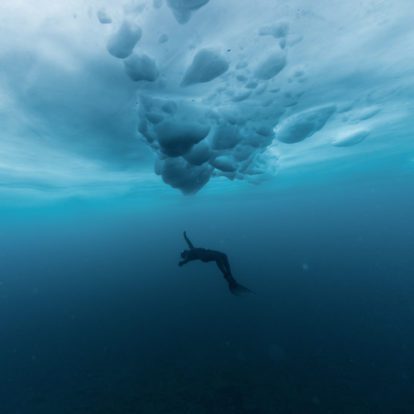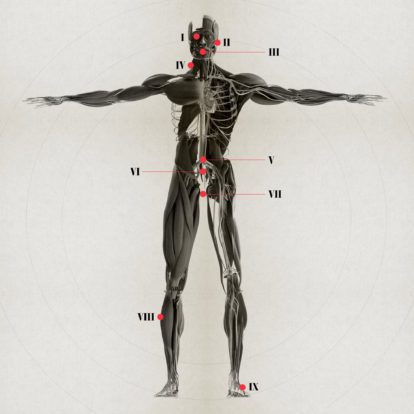In space, no one can hear you scream – or so read the tagline to Alien, the 1979 science-fiction classic. The producers’ reasoning, besides a great bit of marketing, was that sound waves need some type of medium in which to travel, and the vacuum of space doesn’t fit the bill. Or does it? In fact, as Albert Einstein said 100 years ago, space and time have a stretchy, supple nature. You can wiggle them simply by waving your hands. If your arms were large enough, and you could move them fast enough, the disturbances you would create could even be audible.
In practice, picking up these so-called gravitational waves is an almost hopeless task. Even the ripples produced by a cosmic explosion of epic proportions would be extremely difficult to detect by the time they reached Earth. Yet proving they exist would help to confirm Einstein’s general theory of relativity, the universal law of gravity that shaped the cosmos and explain how we all got here.
Fortunately, physicists love a hopeless task. It may have taken them a century but earlier this year scientists at the Laser Interferometer Gravitational-wave Observatory (LIGO) announced that they had “heard” something far out in the universe. They had recorded a collision between two black holes, which merged to be as large as 62 suns combined, marking the first direct detection of gravitational waves. It was a major test for Einstein’s theory, and the most sensational evidence to date that black holes – which no one has ever actually seen – exist.
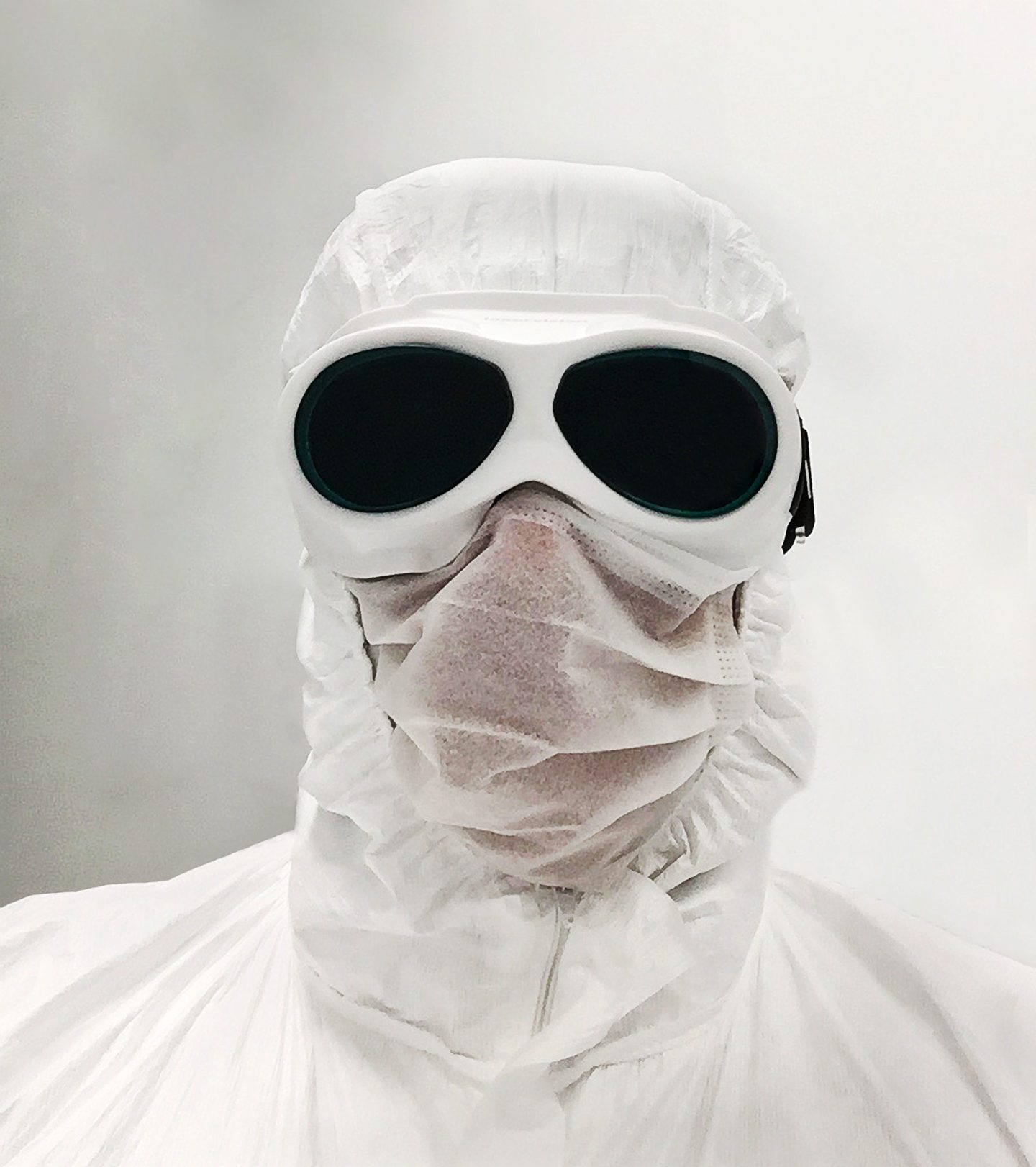
Worker wearing dust-proof overalls to protect against contaminating the Virgo’s highly sensitive equipment.
Although the nature of gravitational waves is rather different to that of acoustic ones, they do readily translate into sound. The black hole event, which LIGO recorded in September 2015, sounded like a bird’s chirp. It had been resonating across the universe for a long time, perhaps billions of years, but we were only able to catch its last gasp, a mere fifth of a second, and then it was gone. But the discovery opened a whole new field of exploration, giving scientists another way to observe space.
Later this year, LIGO’s two huge, five-mile-long detectors in the United States will resume listening, flanked this time by a European counterpart, the Italy-based Virgo. For centuries, we have observed the visual side of the sky. Now the time has come to add a soundtrack to the movie of the universe.
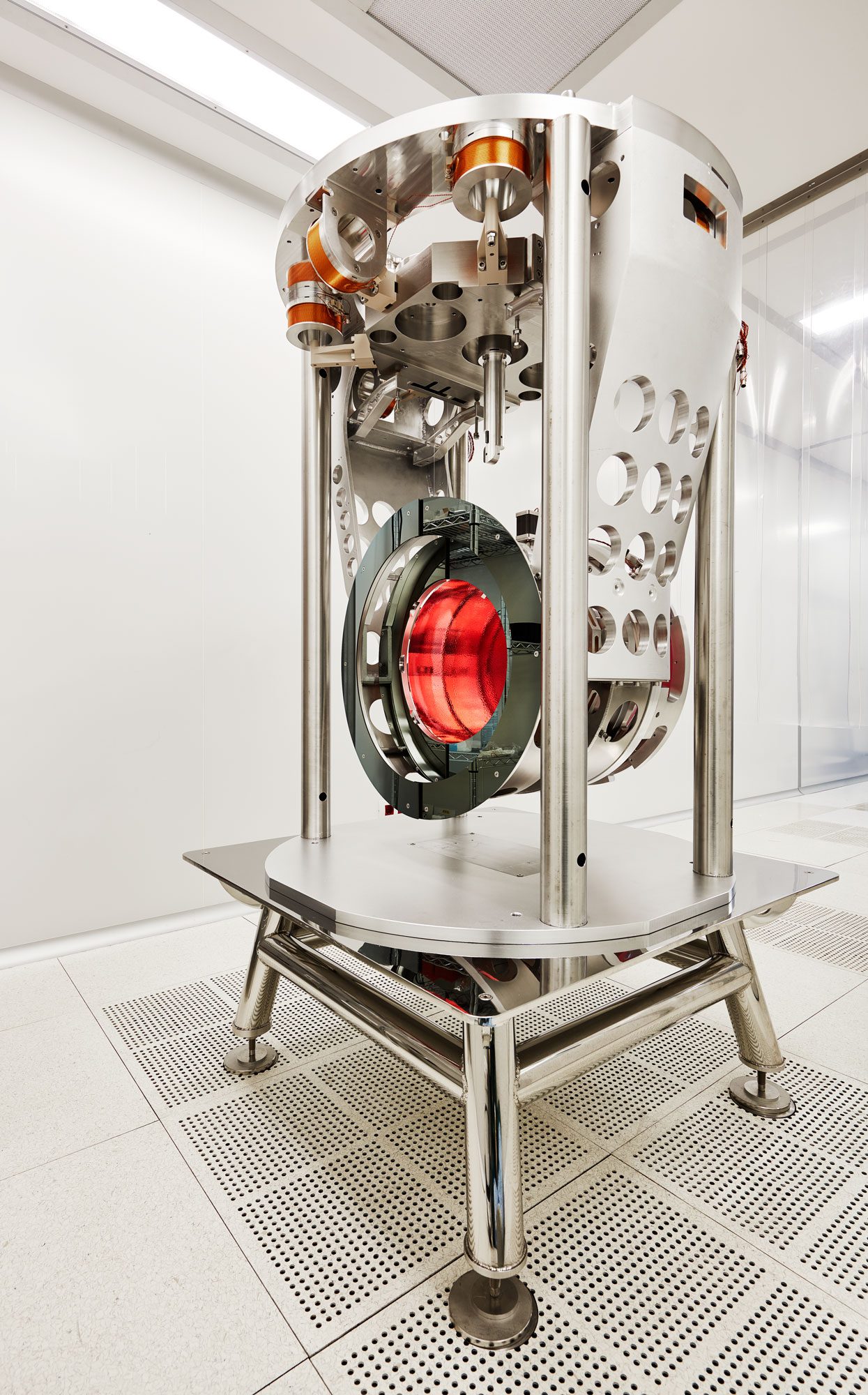
The mirrors of Virgo are isolated from seismic vibrations from the ground through the superattenuator, a sophisticated system of cascaded filters capable of cancelling off noise in the frequency range where the detector operates.
The challenge of detecting gravitational waves can be summed up in one number: 10-21.
Ten to the negative 21. One part in 10 to the 21. One sextillionth. That was the size of the disturbance in space that LIGO and Virgo were designed to detect. To put that in context: scientists measure the distance between the Earth and the Moon to plus or minus two centimetres, an accuracy of 10-11. To find gravitational waves you have to be 100 billion times more accurate. It’s equivalent to measuring the change of a hair’s width in the distance from the Sun to the nearest star.
“When an engineer hears 10-21, they say, ‘You are out of your mind’,” said Rai Weiss, the 83-year-old who is considered the principal inventor of LIGO, in a talk the day after the announcement in February.
The Massachusetts Institute of Technology professor was speaking in the same building where, in 1994, he and his colleagues secured support from the National Science Foundation, a US funding agency, for an undertaking that many thought was impossible and which many scientists opposed. At around the same time in Europe, a group of French and Italian physicists were making a similar case to their own governments for a project called Virgo. (LIGO ended up costing $620 million, Virgo around €200 million.)
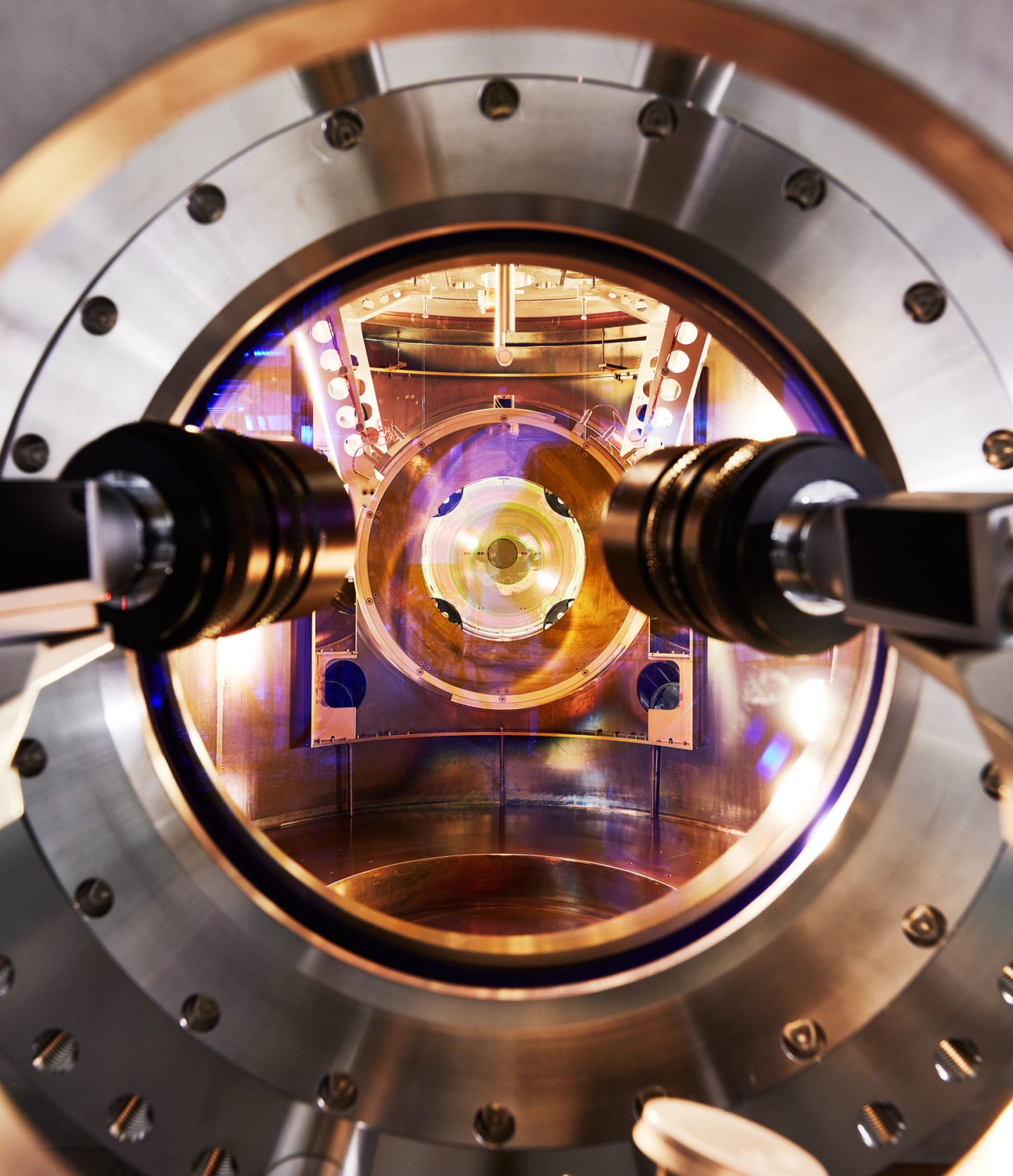
Two cameras observing a mirror at the end of one of Virgo’s 2.5-mile-long arms.
The theme of insanity pops up again and again when you talk to the protagonists of this story. Adalberto Giazotto, a co-founder of Virgo, said that building the massive detectors was a “folly”. And Barry Barish, who served as the laboratory’s director for more than a decade from 1994 and is the person most credited for making it happen, said: “This could only be done because the word ‘crazy’ applies to it.”
Virgo’s single machine in the countryside outside Pisa, and LIGO’s twin detectors, one in Washington state and one in Louisiana, differ in a number of technical details, but they are all based on the same principle. They both split a laser beam in two, and then shoot the two halves down huge steel pipes arranged at right angles to each other, forming an ‘L’. The two arms are each as long as a large airport runway (2.5 miles for LIGO, nearly two miles for Virgo) and all the air has been sucked out of them.
At the opposite ends, the beams bounce off mirrors, and – we’ll skip some of the more technical details – when they come back they are compared to each other. The slightest mismatch could mean that either the mirrors or the laser device are shaking. But if you keep everything absolutely still and see mismatches anyway, it must be space itself – that is, the distance between the laser and the mirrors – that has changed. Einstein’s theory predicted this would happen during the passage of a gravitational wave.
The reason for the ‘L’? Comparing the two beams reveals much tinier distortions than monitoring a single one as gravitational waves tend to shrink one arm while stretching the other.
In practice, picking up these so-called gravitational waves is an almost hopeless task. Fortunately, physicists love a hopeless task.
Keeping the mirrors still means keeping them really still. Things that can throw the detectors off-kilter include nearby traffic, ringing telephones, aeroplanes taking off or waves crashing on beaches hundreds of miles away. But perhaps the most insidious form of noise is that produced by the contraption itself, by the laser’s energy, for example, making the mirrors vibrate “like violin strings”, in the words of Virgo director Fulvio Ricci. To get the detectors to perform as required can take months or even years of fine-tuning, he added, and “you have to work with a knife between your teeth”.
Both LIGO and Virgo ran for several years in the 2000s, mostly to develop their techniques; they knew they probably weren’t sensitive enough to make detections. Then, early this decade, they both shut down for lengthy overhauls aimed at improving their sensitivity by lowering that troublesome unwanted noise.
On 15th September 2015, LIGO had not officially restarted but both detectors were on, running preliminary tests. That was when the chirp arrived, in the middle of the night. The Americans had got one over on Virgo, whose upgrade was only completed this year. The two teams, however, form a single collaboration and news of the discovery was jointly published.
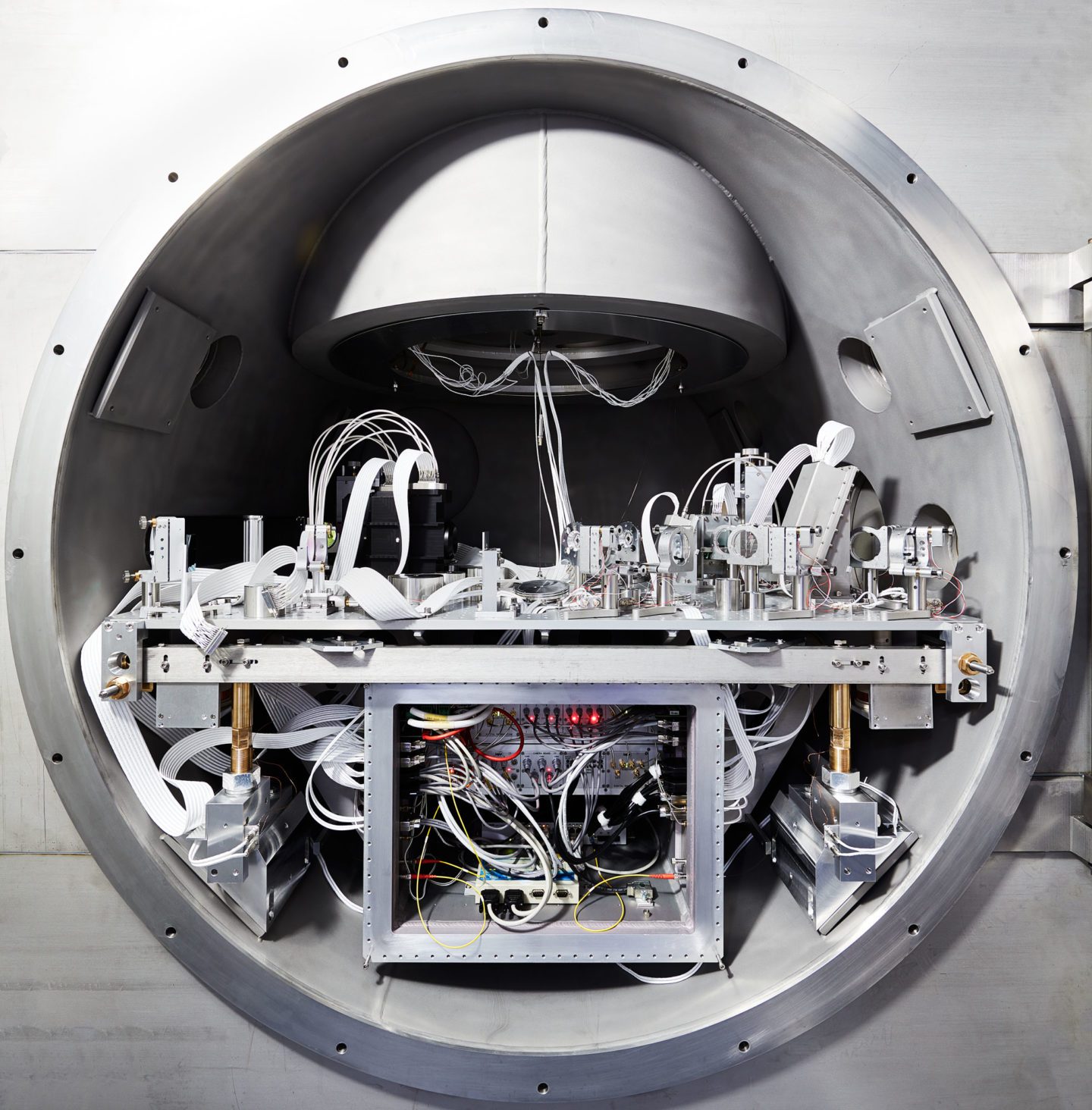
One of the suspended benches supporting Virgo’s under-vacuum photodetectors.
Tiny as the waves were, the event that generated them certainly was not. At its peak, the collision of the black holes radiated out as much energy in gravitational waves as all the stars in all the galaxies in the entire observable universe, 50 times over. Even after travelling at the speed of light for more than a billion years to get to Earth, they still inundated our planet with an amount of energy comparable to the brightness of a full moon.
So why weren’t the waves easy to detect? The reason even such strong waves are so hard to capture, said LIGO physicist Laura Cadonati, is that the fabric of space-time is “an extremely stiff medium”: bending it by an appreciable amount – that tiny one part in a sextillion – takes a staggering amount of energy, and even then it barely displaces LIGO’s beams.
“This could only be done because the word ‘crazy’ applies to it.”
Barry Barish
According to Weiss, LIGO’s discovery of gravitational waves marked “a wonderful closure to a tortured history”.
Einstein first proposed his general theory of relativity in November 1915. It said that space and time can bend, a bit like the surface of a mattress if you place a bowling ball, representing a celestial body, in the middle of it. Massive objects exert a gravitational attraction because they warp that fabric, and smaller objects orbit them in a similar way to how marbles rolled on to the mattress would race towards the heavier ball.
The following year, Einstein realised that according to his own equations, accelerating masses – anything from waving hands to colliding black holes – should produce space-time ripples, that is, gravitational waves. His 1916 paper on the subject contained a crucial – and rare – mistake, but he then published a corrected version in 1918. But because of subtleties in the theory many physicists doubted that the waves were real, and in 1936 Einstein reversed himself, saying that perhaps the sceptics were right.
By then, however, Einstein’s general relativity had fallen into a dark corner of science. For several decades, most researchers regarded the whole space-time-bending thing as a mathematical curiosity, with virtually no practical implications and little experimental evidence to support it. It was only in the late 1950s that mainstream physicists again began to show interest.
Over the following decades, the story of gravitational waves went through several triumphs as well as setbacks. In the 1960s, Joe Weber, a former US navy commander and an ingenious inventor, was the first person to make a serious attempt at detecting them. He built solid aluminium cylinders that he thought would resonate at the passage of the waves and covered them with sensors, and in 1969 he announced that he was picking up gravitational waves on a regular basis. Weber’s work created a ruckus in the science world and many others raced to build their own detectors.
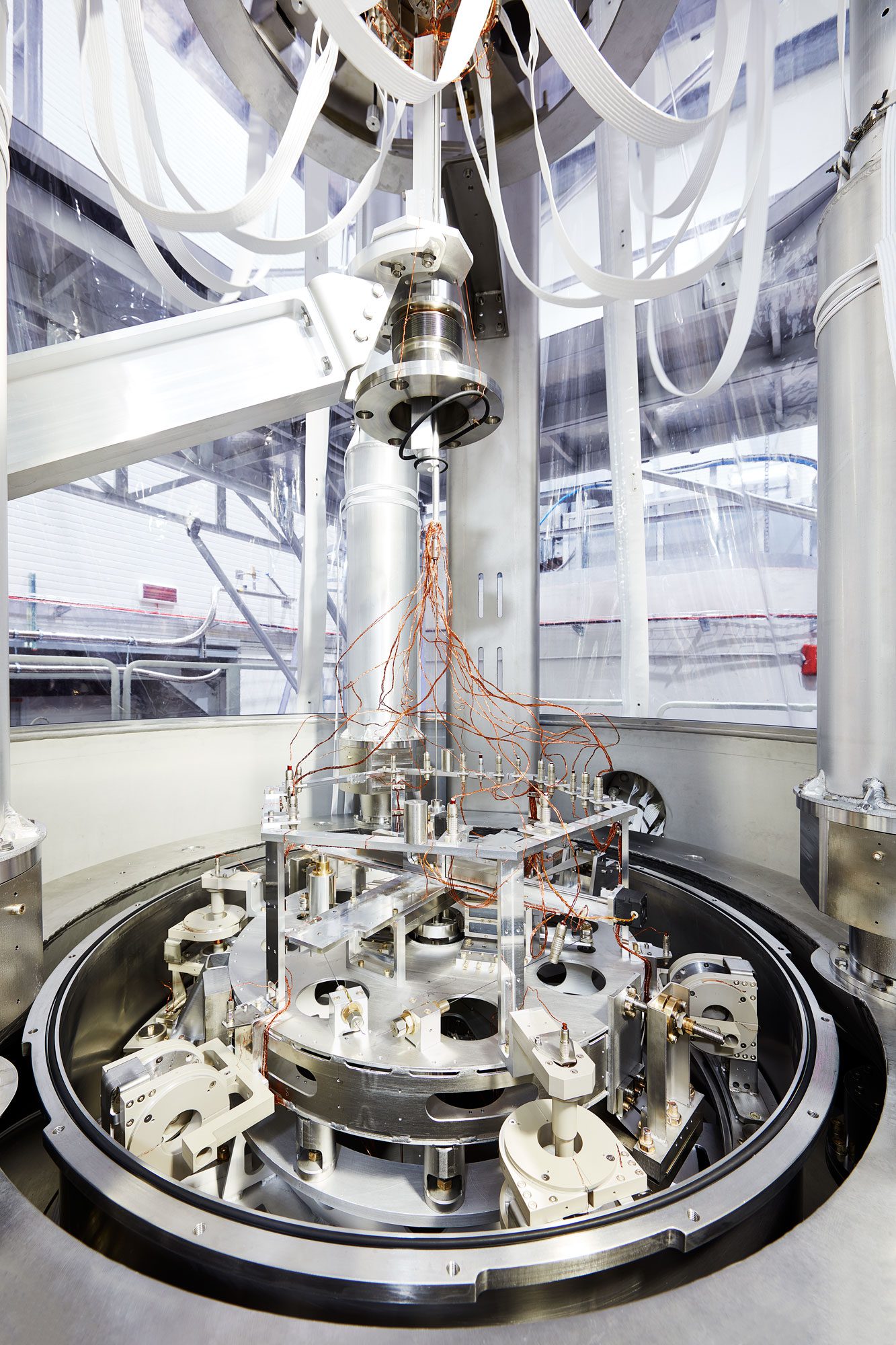
A so-called ‘Virgo payload’: the mirror (protected by a pink layer, to be removed at a later stage) is embedded into a structure, aimed to control its position with great accuracy. This structure will finally be suspended from a superattenuator to achieve the necessary isolation from ground vibrations.
But many researchers pointed out that Weber-like devices could not be sensitive enough to make a detection, unless all calculations of the waves’ expected strengths were way off. And it soon became clear that Weber had been deluding himself by cherry-picking his data. “He was a great technologist, but a terrible scientist,” said Barish.
“Still, if we hadn’t had Joe Weber,” said Harry Collins, a British science sociologist with an intimate knowledge of LIGO, “we would have no gravitational-wave detection nowadays. You need people to do impossible things.”
The Weber controversy had not been fully resolved when, in 1974, two American radio astronomers made a genuine breakthrough: they found two neutron stars – compact remnants of exploded stars – that were slowly spiralling into each other. The implication was that the two orbs were losing energy by radiating it as gravitational waves, exactly as Einstein’s theory predicted they should do. Although the astronomers had not actually detected the waves directly, most scientists saw it as convincing evidence of their existence. The pair, Russell Hulse and Joseph Taylor, received a Nobel Prize in 1993.
Meanwhile, US theoretician Kip Thorne, another co-founder of LIGO and a co-producer of the film Interstellar (noted for its realistic depictions of black holes), realised that the next task was to have a better mathematical grasp of what the waves might look like. This was essential if detectors were to have any hope of finding them and extracting useful information. After making progress with pen-and-paper techniques, researchers in the 1990s began to make detailed computer simulations of the last moments before two black holes collide. But the calculations got out of control and the programs kept crashing.
“It was a pretty depressing time in the field,” said Frans Pretorius, a physicist now at Princeton University. “No one wanted to believe it, but perhaps there was something fundamentally ill-posed about Einstein’s equations that we couldn’t solve.” The relief came in 2005 when Pretorius, working alone, honed his calculations and succeeded in performing the first full computer simulation of a black-hole merger.
But the fiascos were not over on the experimental side. In 2014, cosmologists with the BICEP2 experiment, a US-built telescope at the South Pole, announced that they had recorded indirect evidence of gravitational waves. They said that radiation left over from the big bang – which they had captured in exquisite, unprecedented detail – carried an imprint of gravitational waves produced at the very beginning of the universe. The discovery would have opened a new window on the first moments of creation. Within months, however, the team had to withdraw their claim as it became clear that a much more mundane source, interstellar dust, could mimic the signature of gravitational waves in BICEP2’s cosmic map.
But there have been no such retractions at LIGO and Virgo. “I still pinch myself,” says Barish of the collaboration’s remarkable discovery. The two machines will now go on gathering more evidence of gravitational waves, validating each other’s findings and paving the way for more planned detectors in India and Japan.
Together these huge experiments will help to produce an ever richer picture of this Einsteinian space oddity, adding to our fundamental understanding of the universe around us – and, perhaps, coining another killer tag line for a space movie.


